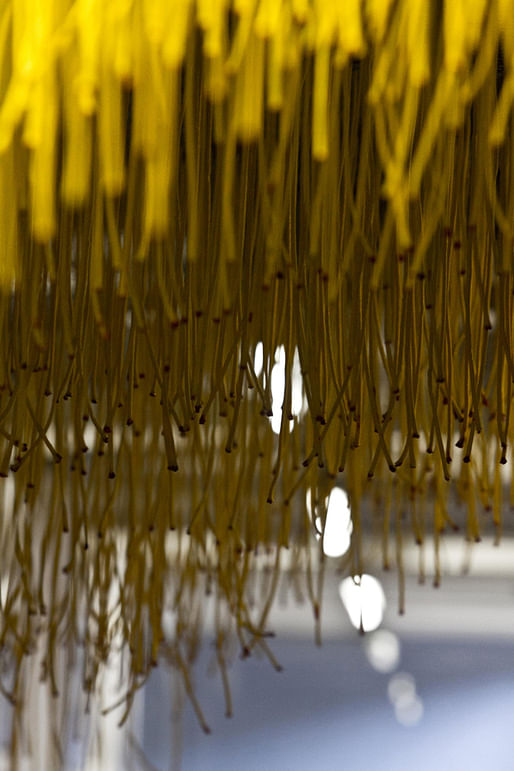
The SONAR installation was conceived and built during the 1st Parametric Design Workshop at Universidade Católica de Pernambuco (UNICAP), Brazil. Applying Grasshopper and Rhinoceros as key design tools, the idea was to capture the lively relationships that take place on the main integration axis in the Campus to where social gatherings, daily conversations and meals converge, bringing these into the Architecture School building, a typical modernist structure punctuated by long boring corridors. — Coletivo-rt
Parametrizing the sound of the street - SONAR installation
Do the sounds of the street have shape?
This installation was conceived and built during the 1st Parametric Design Workshop at Universidade Católica de Pernambuco (UNICAP), Brazil, a pioneer initiative in the State, which focused on applying Grasshopper and Rhinoceros softwares as a design tool. For six days, a group of 25 architecture students and young architects, under the guidance of professors Victor Sardenberg, Ana Luisa Rolim and Robson Canuto da Silva, gathered to discuss theoretical aspects of and practice parametric design, aiming to build temporary low-budget installations at UNICAP campus. The Sonar was one of these installations.




As opposed to typical campuses in Brazil, mostly designed under modern architecture principles that reproduced the garden city model, privileging the maximization of open spaces, the campus at UNICAP occupies traditional urban blocks in the heart of the city of Recife - a major capital in the Northeast of the country -, with the pilotis (and semi-pilotis) typology, as well as proto-modern buildings. In this urban context the Rua do Lazer (“Leisure Street”) is the main integration axis in the Campus, a lively and democratic space to where collective activities, social gatherings, daily conversations and meals converge, connecting two of the blocks in the Campus.

The proposal’s main idea behind this installation is to capture the lively relationships that take place on “Leisure Street”, based on the noise of the environment, perceived as the moving sound of the street. As different types of sound converge to this space, they generate a heterogeneous profile of intensity and frequencies along the street. We recorded 15 seconds of the sound at each 15 meters of the street, totalizing twelve recordings, later condensed into one single recording. We then transferred this recording to Processing software, which by reading the recorded sound, conveyed it into 3-dimensional data that took the shape of something similar to a cloud of points in virtual space. This was the first formal expression of the digital shape of the sound we had recorded in the street.


The spatial data obtained through Processing was carried into Grasshopper. We selected the central portion of the cloud (generated through Processing) due to is complexity, discarding the acute and grave sounds, which formed the flatter, peripheral section of the cloud. This central portion was then converted into a NURBS surface in Grasshopper. We adjusted the scale of the surface to fit on the 1st floor corridor of the Architecture School building, located at Block D in the campus. Once the scale was resolved, we flipped the surface upside down, so that the final shape would allow for a more direct interaction with the passer-by. To facilitate construction in a timely manner – approximately two days - using Grasshopper, the final surface was fragmented into linear elements, as to allow the shape to express the density of the sound while maintaining the curvilinear profile as close as possible to that of the original recording.


In order to meet construction low budget and time constraints – a 5-day workshop with 2 days dedicated to construction - the tectonics of the installation consisted of simple, easily available materials with high visual impact aesthetics. We used 4mm yellow nylon cords connected to metal hooks at one end. Approximately four thousand pieces of cords were cut to match dimensions provided by Grasshopper. These were numbered and organized on flat surfaces accordingly, and then, hung by hand on a perforated plastic screen attached with zip ties to existing metal tracks on the corridor ceiling and walls. The tips of the cords were hand painted in red color to emphasize the expression of the shape of the sound.

The Sonar installation, located at a chaotic corridor overloaded with metal tracks, graduation plaques and various types of doors, helps neutralize these elements, and, more importantly, bring the vivid atmosphere of the street into the building, punctuated by boring narrow corridors. Perhaps that is why the installation has been provoking both estrangement and interaction among students and faculty, who have been constantly staring at or touching the structure in search of an unusually fun tactile experience.

Design team: Ana Luisa Rolim, Erica Costa, Diego Pessoa, Rafaela Teixeira, Robson Canuto and Victor Sadenberg
Location: Universidade Católica de Pernambuco (UNICAP), Recife, Brazil
Construction date: April 2014
Construction materials: 4mm nylon cords, metal hooks, perforated plastic screen, plastic zip ties, red color fabric paint and packaging tape
No Comments
Block this user
Are you sure you want to block this user and hide all related comments throughout the site?
Archinect
This is your first comment on Archinect. Your comment will be visible once approved.